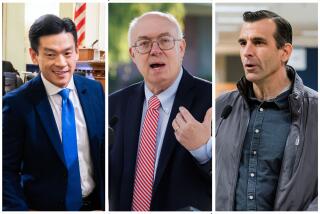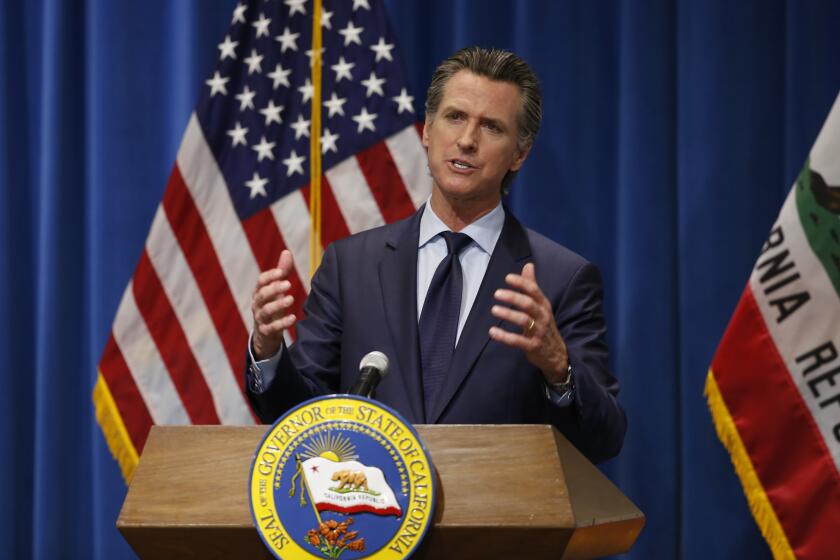Top-two primary might be bad for small-party candidates

When California voters decided to change the way the state’s primary elections work, the move was cast as an effort to moderate a state Capitol gripped by polarization.
If the top two vote-getters in a primary faced off against one another in November regardless of their party affiliation, the reasoning went, hard-nosed politicians who typically put party purity above all else would be forced to court less partisan voters. That could mean more centrists elected to office, more political compromise and better governance.
But with the approach of only the second election since the enactment of the “jungle” primary — the first featuring candidates for statewide office — some argue that the change has had a decidedly undemocratic effect, muzzling the voices of small-party candidates.
The Green Party, the American Independent Party and other minor groups will now rarely — if ever — appear on the general election ballot, even though they represent 1.2 million people. And they could eventually find themselves out of existence in California, the critics fear.
“It’s just a violation of voting rights,” said Richard Winger, a Libertarian and publisher of the San Francisco-based Ballot Access News. “Because the right to vote includes the right of the choice.”
Antiwar and social justice activist Cindy Sheehan, running for governor as a member of the Peace and Freedom Party, paints a more dire picture. “It seems designed to kill our parties,” Sheehan said.
Membership outside the Democratic and Republican parties and among those who state no party preference is admittedly a sliver of California’s electorate. And every party has equal footing — at least theoretically — in the current primary system, which voters approved in 2010 for all races except presidential contests.
But already, far fewer third-party candidates have been able to qualify for the general election ballot.
In June 2012, with more than 150 races taking place under rules being applied for the first time, only three minor-party candidates made it to November. This year, no third-party candidate is likely to appear on the fall ballot for governor, attorney general or other high office.
It is more costly now for small parties to place a candidate on the ballot. Previously, Democratic or Republican candidates for statewide office had to pay a filing fee of $2,610 to $3,480 or gather the signatures of 10,000 registered voters to make the cut. But members of smaller parties were allotted a sharp discount and needed only as many as 150 signatures to avoid the fee.
This resulted in a plethora of candidates qualifying for the ballot. In 2010, 33 candidates representing smaller parties ran for statewide office, from the Green, Libertarian, Peace and Freedom, and American Independent parties. Because of closed party nominations, each party was guaranteed a spot on the November ballot.
This year, the filing fees are the same but there are no discounts for small parties. Now, there are only 10 candidates for statewide office from seven minor parties. And barring a major upheaval, none will proceed past the June primary because most Californians still vote for Democrats or Republicans.
“There’s no question that the minor parties are disadvantaged by the top-two rule,” said Richard Hasen, a law professor at UC Irvine who specializes in elections.
By contrast, candidates who do not register with a political party have benefited from the change. In the 2010 California primary, all candidates for statewide office had a party affiliation; this year, there are eight who state no party preference.
The occasional third-option candidate has won in California. The Green Party’s Audie Bock won a state Assembly seat in a special election in 1999. Another Green Party member, Gayle McLaughlin, was elected mayor of Richmond in 2006.
In other states, Angus King won a U.S. Senate seat in Maine in 2012, and Lincoln Chafee won the Rhode Island gubernatorial contest in 2010, without party affiliations. Reform Party candidate Jesse Ventura won the Minnesota governorship in 1998.
Such candidates can shape campaigns even if they don’t win, Hasen said, citing the effect of an unaffiliated Ross Perot on the 1992 presidential contest.
“His mantra was deficit reduction, and it became a major factor in the campaign,” Hasen said. “In fact, it became something Bill Clinton adopted as one of his priorities. It never would have happened if not for Perot…. Losing minor parties does make the debate less rich.”
Efforts are underway to offer relief to those groups.
The Green, Libertarian, and Peace and Freedom parties are pressing a lawsuit on appeal in state court alleging disenfranchisement and other harms, with a new argument filed April 3. And an Assembly bill that would reduce the level of support required for a minority-party candidate to be recognized by the state will be the subject of an upcoming hearing.
Some who supported the new primary rules are unmoved, arguing that their effort was aimed at helping voters, not political parties.
“Our position is about [improving things for] voters, not candidates,” said former Democratic state legislator Steve Peace, whose Independent Voter Project was instrumental in persuading voters to approve the new primary system.
He added that the proposition provided a measure of fairness. “Now the process is the same for every candidate — they are all treated equally.”
Other proponents of the primary overhaul said they never intended to punish small parties.
“Obviously, the need for third parties, smaller parties, to remain active participants is important; and as we implement this system, the need to make appropriate adjustments will become apparent as the system unfolds,” said Adam Mendelsohn, an advisor to former Gov. Arnold Schwarzenegger and the media strategist for the campaign to change primaries.
“The most important part of this was preventing or stopping the continued dominance of the extremes of the Republican and Democrat parties to control the electoral process,” Mendelsohn said.
Experts say the effect of the jungle primary remains unknown, that most studies are inconclusive and complicated by the fact that the overhaul took place at the same time as the inauguration of independent redrawing of voting districts.
“It needs to run at least another cycle or two more before we can understand its effects, particularly on third-party candidates,” said Caltech political science professor R. Michael Alvarez, who is working on a study of the new system.
More to Read
Sign up for Essential California
The most important California stories and recommendations in your inbox every morning.
You may occasionally receive promotional content from the Los Angeles Times.












